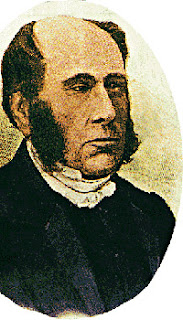Rev. Patrick Bell (1799-1869)
Patrick Bell, a member of the Scottish clergy, was an inventor and a famer's son. In 1826, he invented his reaping implement which was the first practical mechanical reaper designed in Britain.
Bell's Reaper
Artist: Sheila Terry
It was mounted on two wheels and pushed by draft horses. The grain was cut and gathered together before the horses could trample it. The modern day combine harvester is based on the combination of Patrick Bell's Reaper and Andrew Meikle's Thresher.
Bell's Reaper
Cyrus Hall McCormick (1809-1884)
McCormick was the eldest son of Robert McCormick, farmer, blacksmith, and inventor, born in beautiful Rockbridge County, Virginia. With limited education, he spent all of his time in his father's workshop.
McCormick's Reaper
Cyrus (at 22 years of age) tried his hand at building a reaper in 1831. It was pulled (rather than pushed) by draft horses and consisted of a vibrating cutting blade, a reel to bring the grain within its reach, and a platform to catch the falling grain. The center wheel spun and the paddles pushed the crop onto a moving cutter bar and knife. McCormick patented his invention in 1834, made his first sale in 1840 and moved to Chicago in 1847 to begin large-scale production. He was convinced that the vast fertile land of the Midwest would serve as a better setting for his reaper than the rocky, hilly East. The six million harvesters he manufactured opened the prairie lands to intensive agriculture, a major factor in America's prosperity. In 1902, McCormick Harvesting was joined with other companies to form the International Harvester Company.
Photo: Science Photo Library
Obed Hussey (1792-1860) was born to a Quaker family in Maine. He was a tireless inventor and gained fame when he patented the first working reaping machine in 1833.
Hussey's Reaper (1838-1845)
Lithograph: Ed Weber & Co., Baltimore, Maryland
(Precursor to A. Hoen & Co.)
Manufactured by the Patentee in Baltimore, Maryland, this reaper was, "Warranted to cut fifteen acres of heavy wheat in a day, the grain taken as clean and left in as good order for binding as when cut by the scythe or sickle." Further notoriety followed Hussey due to the long rivalry with McCormick for the improvement and sale of reapers in the U.S. This was a contest McCormick eventually won in 1858.
Some Antique Hand Implements
Machete (Ontario Knife Co.), Sickles (2), Draw Knife (Bridge Tool Co.)
When the historian of the future comes to speak of the great Americans . . . who have succeeded the best in lightening the burdens of mankind, by the side of Franklin, and Fulton and Joseph Henry and Morse, they will not forget to mention Cyrus H. McCormick. Where the golden wheat rustles in the breeze, the panting toilers under the hot sun will hail him as their benefactor.
~ S.C.P. Miller, In Memoriam: Cyrus Hall McCormick
.•°*”˜☆˜”*°•.˙·٠•●♥ Ƹ̵̡Ӝ̵̨̄Ʒ ♥●•٠·˙.•°*”˜☆˜”*°•.



















